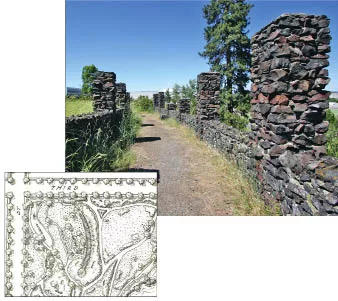Restoration of Liberty Park ruins eyed
City will contribute funds if community also pays part

Those mysterious, crumbling pillars of basalt visible near Third Avenue and Arthur Street and from Interstate 90 could get a new life, city of Spokane officials say.
Known as the Liberty Park Ruins, the 3-acre parcel sits on a bluff just north of the freeway and south across Third from an Office Depot outlet. It was designed by the famed park architects the Olmstead Brothers early in the 20th Century in connection with Spokane's first park bond, and was part of the larger Liberty Park, now located south of the freeway and to the east.
The original Liberty Park was bisected by the new freeway in the 1960s, and the park was redeveloped at its current location to the east. The part of the original park to the north of the new freeway, which the Washington state Department of Transportation bought along with right of way for the freeway itself, ceased to be a park, says Taylor Bressler, parks division manager for the city. Over the years, it has become overgrown with weeds, and all that remains of its original look are the collapsing basalt pillars and walls. Only recently was it deeded back to the city by the DOT.
Now, members of the East Central neighborhood have expressed interest in seeing the park restored and preserved as a city landmark and interpretive area, Bressler says.
While plans for improvements are being discussed, no decisions have been made on any possible restoration yet, and no money has been secured for a project, he says.
Bressler says the city probably won't do a full restoration of the area because too much of what was there originally is missing.
"We would probably just stabilize what there is left. It would be a reminder of the historic development," he says.
The city still has the original designs for the park, as well as aerial photographs and maps that show the layout of the park, Bressler says.
Right now, the main concern is that the crumbling ruins are unsafe for the public to enter, he says.
"To make it safe for public access we need railings and graded pathways. We can't invite the public into it because it's not safe," Bressler says.
Back in its prime during the 1920s, the original Liberty Park featured expansive walkways, lawns, ponds, gardens, and even a wading pool, Bressler says.
"It certainly was an attractive park at its height," he adds.
If restoration eventually goes ahead, the city's parks division would contribute some funds if the neighborhood contributes as well, Bressler says.
Currently, the park ruins is public land that is open for recreation, he says.
Related Articles



_web.webp?t=1764835652)
